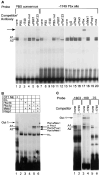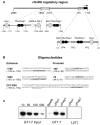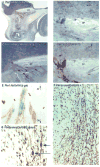TALE homeodomain proteins regulate gonadotropin-releasing hormone gene expression independently and via interactions with Oct-1
- PMID: 15138251
- PMCID: PMC2935805
- DOI: 10.1074/jbc.M402960200
TALE homeodomain proteins regulate gonadotropin-releasing hormone gene expression independently and via interactions with Oct-1
Abstract
Gonadotropin-releasing hormone (GnRH) is the central regulator of reproductive function. Expression of the GnRH gene is confined to a rare population of neurons scattered throughout the hypothalamus. Restricted expression of the rat GnRH gene is driven by a multicomponent enhancer and an evolutionarily conserved promoter. Oct-1, a ubiquitous POU homeodomain transcription factor, was identified as an essential factor regulating GnRH transcription in the GT1-7 hypothalamic neuronal cell line. In this study, we conducted a two-hybrid interaction screen in yeast using a GT1-7 cDNA library to search for specific Oct-1 cofactors. Using this approach, we isolated Pbx1b, a TALE homeodomain transcription factor that specifically associates with Oct-1. We show that heterodimers containing Pbx/Prep1 or Pbx/Meis1 TALE homeodomain proteins bind to four functional elements within the GnRH regulatory region, each in close proximity to an Oct-1-binding site. Cotransfection experiments indicate that TALE proteins are essential for GnRH promoter activity in the GT1-7 cells. Moreover, Pbx1 and Oct-1, as well as Prep1 and Oct-1, form functional complexes that enhance GnRH gene expression. Finally, Pbx1 is expressed in GnRH neurons in embryonic as well as mature mice, suggesting that the associations between TALE homeodomain proteins and Oct-1 regulate neuron-specific expression of the GnRH gene in vivo.
Figures





Similar articles
-
Oct-1 binds promoter elements required for transcription of the GnRH gene.Mol Endocrinol. 1998 Apr;12(4):469-81. doi: 10.1210/mend.12.4.0092. Mol Endocrinol. 1998. PMID: 9544983
-
The POU homeodomain transcription factor Oct-1 is essential for activity of the gonadotropin-releasing hormone neuron-specific enhancer.Mol Cell Biol. 1995 Nov;15(11):6169-77. doi: 10.1128/MCB.15.11.6169. Mol Cell Biol. 1995. PMID: 7565769 Free PMC article.
-
Identification of a discrete promoter region of the human GnRH gene that is sufficient for directing neuron-specific expression: a role for POU homeodomain transcription factors.Mol Endocrinol. 2002 Mar;16(3):435-49. doi: 10.1210/mend.16.3.0780. Mol Endocrinol. 2002. PMID: 11875100
-
Developmental regulation of gonadotropin-releasing hormone gene expression by the MSX and DLX homeodomain protein families.J Biol Chem. 2005 May 13;280(19):19156-65. doi: 10.1074/jbc.M502004200. Epub 2005 Mar 1. J Biol Chem. 2005. PMID: 15743757 Free PMC article.
-
POU domain factors in neural development.Adv Exp Med Biol. 1998;449:39-53. doi: 10.1007/978-1-4615-4871-3_4. Adv Exp Med Biol. 1998. PMID: 10026784 Review.
Cited by
-
Persistent transactivation by meis1 replaces hox function in myeloid leukemogenesis models: evidence for co-occupancy of meis1-pbx and hox-pbx complexes on promoters of leukemia-associated genes.Mol Cell Biol. 2006 May;26(10):3902-16. doi: 10.1128/MCB.26.10.3902-3916.2006. Mol Cell Biol. 2006. PMID: 16648484 Free PMC article.
-
Biochemistry of the tale transcription factors PREP, MEIS, and PBX in vertebrates.Dev Dyn. 2014 Jan;243(1):59-75. doi: 10.1002/dvdy.24016. Epub 2013 Sep 2. Dev Dyn. 2014. PMID: 23873833 Free PMC article. Review.
-
Heterogeneous nuclear ribonucleoprotein A/B and G inhibits the transcription of gonadotropin-releasing-hormone 1.Mol Cell Neurosci. 2008 Jan;37(1):69-84. doi: 10.1016/j.mcn.2007.08.015. Epub 2007 Aug 29. Mol Cell Neurosci. 2008. PMID: 17920292 Free PMC article.
-
Otx2 induction of the gonadotropin-releasing hormone promoter is modulated by direct interactions with Grg co-repressors.J Biol Chem. 2009 Jun 19;284(25):16966-16978. doi: 10.1074/jbc.M109.002485. Epub 2009 Apr 28. J Biol Chem. 2009. PMID: 19401468 Free PMC article.
-
Hormonal regulation of clonal, immortalized hypothalamic neurons expressing neuropeptides involved in reproduction and feeding.Mol Neurobiol. 2007 Apr;35(2):182-94. doi: 10.1007/s12035-007-0010-5. Mol Neurobiol. 2007. PMID: 17917107
References
-
- Wolberger C. Curr Opin Genet Dev. 1998;8:552–559. - PubMed
-
- Vale W, Rivier C, Brown M. Annu Rev Physiol. 1977;39:473–527. - PubMed
-
- Mellon PL, Windle JJ, Goldsmith P, Pedula C, Roberts J, Weiner RI. Neuron. 1990;5:1–10. - PubMed
-
- Eraly SA, Mellon PL. Mol Endocrinol. 1995;9:848–859. - PubMed
-
- Whyte DB, Lawson MA, Belsham DD, Eraly SA, Bond CT, Adelman JP, Mellon PL. Mol Endocrinol. 1995;9:467–477. - PubMed
Publication types
MeSH terms
Substances
Grants and funding
LinkOut - more resources
Full Text Sources

